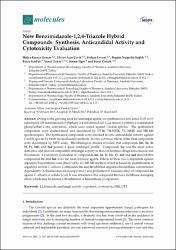New Benzimidazole-1,2,4-Triazole Hybrid Compounds: Synthesis, Anticandidal Activity and Cytotoxicity Evaluation

Göster/
Erişim
info:eu-repo/semantics/openAccessTarih
2017Yazar
Karaca Gencer, HülyaÇevik, Ulviye Acar
Levent, Serkan
Sağlık, Begüm Nurpelin
Korkut, Büşra
Özkay, Yusuf
Öztürk, Yusuf
Üst veri
Tüm öğe kaydını gösterÖzet
Owing to the growing need for antifungal agents, we synthesized a new series 2-((5-(4-(5-substituted-1H-benzimidazol-2-yl)phenyl)-4-substituted-4H-1,2,4-triazol-3-yl)thio)-1-(substituted phenyl)ethan-1-one derivatives, which were tested against Candida species. The synthesized compounds were characterized and elucidated by FT-IR, H-1-NMR, C-13-NMR and HR-MS spectroscopies. The synthesized compounds were screened in vitro anticandidal activity against Candida species by broth microdiluation methods. In vitro cytotoxic effects of the final compounds were determined by MTT assay. Microbiological studies revealed that compounds 5m, 5o, 5r, 5t, 5y, 5ab, and 5ad possess a good antifungal profile. Compounds 5w was the most active derivative and showed comparable antifungal activity to those of reference drugs ketoconazole and fluconazole. Cytotoxicity evaluation of compounds 5m, 5o, 5r, 5w, 5y, 5ab and 5ad showed that compounds 5w and 5ad were the least cytotoxic agents. Effects of these two compounds against ergosterol biosynthesis were observed by LC-MS-MS method, which is based on quantification of ergosterol level in C. albicans. Compounds 5w and 5d inhibited ergosterol biosynthesis concentration dependently. A fluorescence microscopy study was performed to visualize effect of compound 5w against C. albicans at cellular level. It was determined that compound 5w has a membrane damaging effect, which may be related with inhibition of biosynthesis of ergosterol.

















